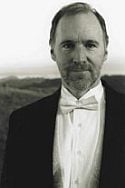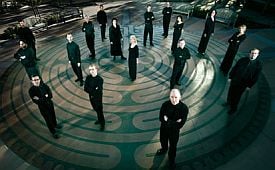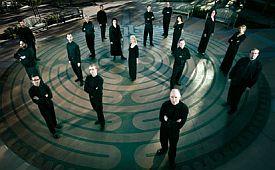
The group has set lofty goals. The more tangible of these include breathing new life into old music, in conjunction with performing compelling modern works. This was accomplished by programming both early liturgical works by composers like Descaudin and de La Rue, and several U.S. and West Coast premieres by contemporary composers.
Specific to this particular program was the goal of examining the widespread roots of music in California — the “international influences on our musical palette.” Before AVE even began to sing, it was clear that this would be a colorful performance. With the singers dressed in bright solid colors and fanned out below a stained glass window, the group’s visual presentation portended the breadth of tonal colors to come. Sergey Khvoshchinsky’s Bogoroditse Devo brought out the darker shades of the palette, with rich, deep chords that gave the basses a chance to truly shine. The stark contrasts in Laudate pueri, by Ola Gjeilo, conjured up a glacier’s infinite shades of blue, as well as the greens and grays of a Norwegian mountainside.
Besides taking a look at influences on California, the program was also meant to project the state’s influence on the rest of the U.S. and even the world. Several of the early works were performed with saxophone improvisation, to add a bit of Golden State flair. In Morales’ Parce mihi Domine, saxophonist Dann Zinn sounded as though he was simply adding an extra layer of polyphony, blending beautifully with the choir. His improvisations on O Salutaris Hostia (by Pierre de La Rue) and Vray dieu d’aymer (by Descaudin), however beautifully played, became a bit obtrusive. The a cappella–plus–saxophone ensemble might work better in a recording studio, where the balance could be controlled. Tantum ergo (by Fredrik Sixten), a Swedish work with a wealth of jazz-influenced tonalities, would have been a more likely candidate for saxophone improvisation than the aforementioned 16th-century selections.
California composer Eric Whitacre was represented, as well. Dimmock’s interpretation of Whitacre’s i thank you, God seemed a bit rushed in some sections, yet gave an interesting new perspective on others. For this piece, the group eschewed their semicircle in favor of a block, with all the singers quite spread out. The arrangement allowed individual voices to be heard through the thick, active textures, creating an entirely different listening experience.
Soaking Up Inspiration

The spectrum of emotions elicited by the performance was as broad and varied as that of the visible and audible colors performed. AVE’s more subjective goals run along the lines of creating a space for personal reflection, which can, they believe, “aid in healing a very broken and divided world.” In a best-case scenario, this healing would inspire listeners to engage in social action; this particular concert, for example, was linked with the Slow Food Movement. The music is a gift, but it is also a call to action, as AVE plans its concerts “to move our listeners rather than impress them.”
On Friday, AVE managed to do both. Listeners were impressed by a group of capable soloists who also blended wonderfully as an ensemble, and were moved by a thoughtful program that brought together many of the colors of California’s “musical palette” and painted an aural picture of the state’s choral music. This “California Fusion” program gave listeners a chance to feast their ears on the local sound ingredients that make up the musical equivalent of slow food — California style.

